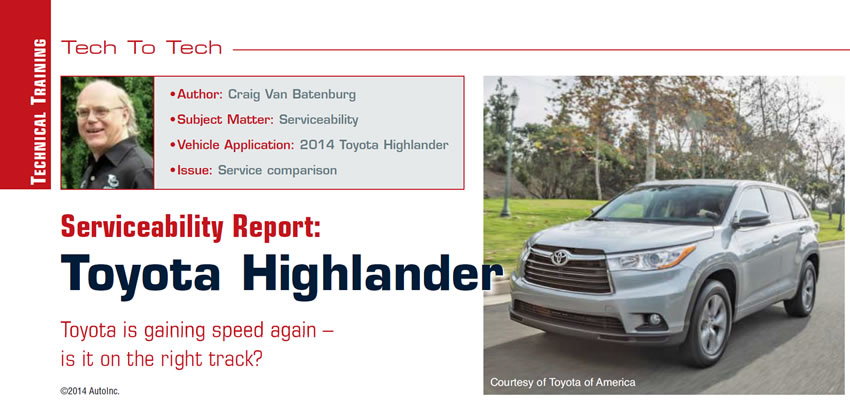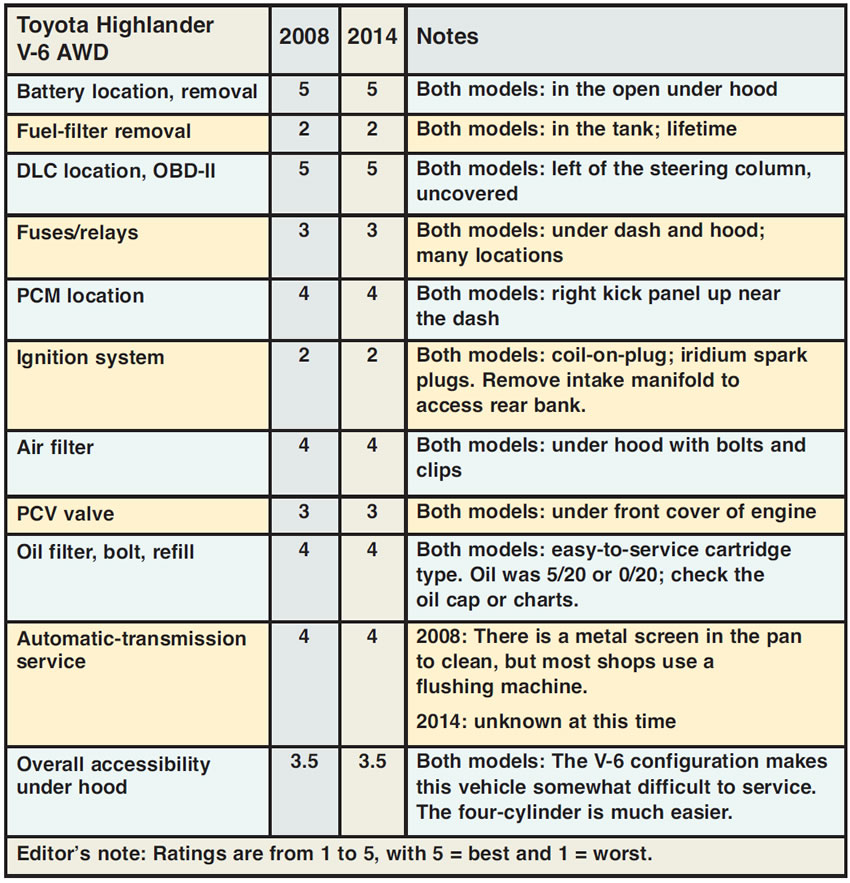
Tech to Tech
- Author: Craig Van Batenburg
- Subject Matter: Serviceability
- Vehicle Application: 2014 Toyota Highlander
- Issue: Service comparison
Toyota is gaining speed again – is it on the right track?
Once more we will examine a new model that has just been re-engineered. Is fixing and maintaining a 2014 Toyota Highlander less difficult than fixing and maintaining the earlier model? Were technicians considered at the design stage? Let’s find out. Let’s examine the 2008 Highlander V 6 all-wheel-drive (AWD) system and compare it with the current 2014 model.
2014 Highlander
Toyota has improved its Highlander for 2014 in many ways. It is more spacious, more upscale and safer than the model it replaces.
This midsize sport/utility vehicle has been a hit since it was first introduced as a 2001 model. Toyota sold more than 127,000 Highlanders in 2013, up by 26% from the previous year. The last major change was in model year 2008.
Driveline
The optional AWD system has been changed to improve fuel economy. In the previous model, it always sent power to all four wheels. Now the power goes exclusively to the front wheels in normal driving. The system sends power to the rear wheels only when the front ones start to lose grip or when the vehicle is accelerating through a turn. The driver is able to view the torque-distribution settings on the meter display. The Dynamic Torque Control AWD system continuously monitors and controls the torque transfer between the front and rear wheels via an electromagnetically controlled coupling positioned in the rear differential.
The AWD system uses information sent from various sensors (speed, steering angle and speed, throttle angle and yaw rate) to automatically govern the transmission of torque to the rear wheels as required. The AWD system has a “locking mode” for really slippery conditions. It splits power evenly between the front and rear wheels as long as the Highlander stays at low speeds.


Fuel economy for the V 6 engine is up by one mile per gallon overall, thanks in part to a new six-speed transmission that replaces the outgoing model’s five-speed. The EPA rates the Highlander’s fuel efficiency at 19 mpg city/25 mpg highway (21 mpg combined) for front-wheel drive, and 18/24/20 for AWD. A four-cylinder engine is offered on the base LE model, and a hybrid powertrain is available on the top Limited trim level. The hybrid system is the same as that of the previous year. The 3.5-liter (the one we are comparing) is equipped with a variable intake manifold and dual variable valve timing with intelligence (VVT-i), which controls phasing on both the intake and exhaust camshafts to optimize torque and fuel efficiency. The generates 270 horsepower at 6,200 rpm and 248 lb.-ft. of torque at 4,700 rpm.
The LE base model is the dependable 2.7-liter four-cylinder engine, equipped with VVT-i, and teamed with a six-speed electronically controlled automatic transmission. It comes with front-wheel drive only; the AWD option is limited to and hybrid versions. EPA fuel efficiency is 20 mpg city, 25 mpg highway and 22 mpg combined.
The 2014 Highlander has new technologies: the previously mentioned Dynamic Torque Control AWD, enhancements in suspension, MacPherson-strut front suspension, double-wishbone rear suspension and four-wheel disc brakes. The rating of 5,000-pound towing capacity is up from 3,500. This is like so many SUVs; they just get bigger.
All the 2014 Toyota Highlanders are holdovers in the internal-combustion-engine department with the six-speed automatic the big change. The body/chassis is all new. The Hybrid Limited is the same hybrid system as in the 2013 model and gets 28 mpg city and 28 mpg highway.

2008 Highlander
In model year 2008 big changes took place. The SUV was longer, wider and taller. The four-cylinder was discontinued and a 3.5-liter engine was your only choice unless you bought the hybrid model, which used a 3.3-liter engine with power augmented by batteries. Both power plants deliver 270 hp – the 3.5-liter hooked up to a five-speed automatic transmission, the 3.3-liter driving a continuously variable transmission. Front- or all-wheel drive was available for the gas engine; the hybrid offered only four-wheel drive with the rear wheels driven by a separate electric motor.
Safety was a big part of the Highlander. Seven airbags, including roll-sensing curtain bags that stretch to all three rows of seats, were standard. For extreme evasive maneuvers that could result in a rollover, Toyota offered stability-control systems.
Researching Identifix, I found a great tip about “idle speed relearn.” According to the Toyota factory manual, there is no idle-speed relearn procedure, but Identifix created one. Look it up if you have any problems with idling. Use “World Standard” automatic-transmission fluid, or ATF-WS, when it is recommended. Refer to the latest Toyota fluid charts. I suggest a transmission-fluid change more often than Toyota recommends, especially on the hybrid model. ATF-WS is NOT compatible with T-IV or Dexron ATF. Containers storing Toyota ATF-WS should always be sealed, because if they are exposed to the atmosphere ATF-WS may absorb moisture and potentially cause shift concerns if used. Toyota says, “One time use only.” When performing repairs on ATF-WS-equipped transaxles, it is important to use only new, clean ATF-WS when refilling the transmission.
2008 summary
Toyota is most likely on your list of vehicles to service for a few reasons. They are money-makers, usually easy to fix, and the factory scan tool is affordable (about $1,400 plus a laptop) and good. Most owners are ready to do the preventive maintenance and will pay for good service.
2014 summary
The new Highlander had not been released when I wrote this article but as a member of the media I had a chance to get to know the 2014. Repairs will be similar to working on the old model, as the driveline has not changed much. Information is easy to access on the Internet, and once you gear up for Toyota/Scion/Lexus you have a lot of vehicles to service. Don’t forget to get ready for hybrids, plug-ins and EVs. Toyota is a leader in that field.

Craig Van Batenburg, AAM, is a master hybrid technician. He was the owner and lead technician for more than 25 years at his own shop that specialized in Honda and Toyota vehicles. Van Batenburg was the president of ASA-Massachusetts from 1993 to 1996. He is owner of the Automotive Career Development Center (ACDC), which he founded in 1998. He develops technical classes for those who require updating their knowledge in hybrid and electric cars. Some of his customers include the U.S. Army, U.S. Marine Corps, Delphi, Midtronics, John Deere, Porsche of America and BG Products. You can reach Van Batenburg at [email protected].
This copyrighted article is reprinted with the permission of AutoInc., the official publication of the Automotive Service Association (ASA). To learn more about ASA and its commitment to independent automotive-service and repair professionals, visit www.ASAshop.org or call 800-272-7467.
Photo credit: Courtesy of Toyota of America













